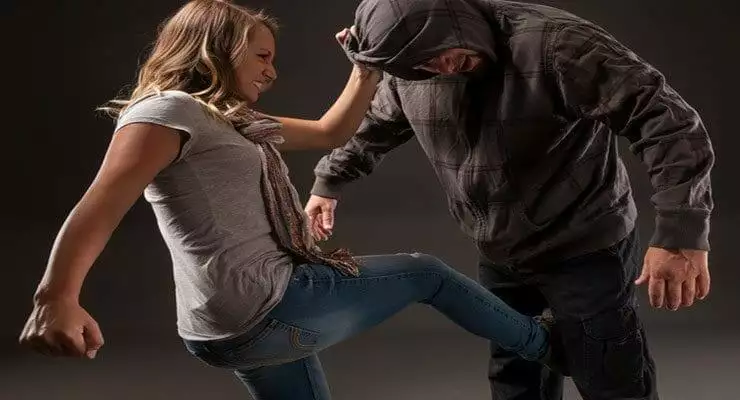I have two teenaged daughters. I’ve worked in domestic violence advocacy for ten years. I am a woman myself. Yet I’ve never taken a self-defense class.
Until last weekend, when I spent two hours with 10 fifteen year old girls and a female instructor who had a black belt in karate and years of self-defense training.
Here are the grim statistics: one in three American women will be victims of domestic violence in their lifetime. One in six will be raped. Teens ages 12 to 19 and young adults ages 20 to 24 experience the highest rates of violent crime. The majority of rape victims are under age 30.
A two-hour self-defense class may not eradicate my daughters’ chances of being victims of violence against women. But nonetheless, we all learned invaluable lessons about protecting ourselves and each other.
Girls are stronger than they realize. In two hours, our self-defense teacher taught us all a few moves to prevent attacks, to get out of hand holds, and to use our legs, knuckles, lungs and elbows to resist and buy ourselves a few seconds to escape. The problem is that girls are rarely taught the facts about assaults, and even more rarely are they taught how to protest an assault, how to hit or hurt others. Girls are actually taught the opposite (to be nice) from an early age. That makes it hard for girls to defend themselves. All 10 girls in our class said they were reluctant – afraid – to hurt someone else, even if that person was intent upon robbing, raping, or murdering them.
So first: girls need to learn that it is ok to protect yourself. They need to hear from parents and other adults that no one needs to be nice when someone is attacking or threatening you.
Second, there are three simple mistakes to teach our daughters to avoid:
- Lack of awareness (not paying attention to surroundings; on phone; using headphones)
- Conveying “soft” body language in public (hunched over, eyes downcast, arms at sides)
- Being alone in a risky place at the wrong time (jogging at night, taking a shortcut through an alley, using a gas station bathroom alone, walking home from a babysitting job on a side street instead of a well-lit main street)
The best self-defense tactic is prevention, and the simplest approach is to avoid dangerous situations. Parking lots and garages, stairwells and an unlocked car all can heighten vulnerability. So does being alone anywhere. We need to teach our daughters to be cognizant of surroundings, to communicate self-confidence, and to avoid dangerous places and situations through simple rules such as always park in a well-lit spot and be aware as you approach your car; take an elevator instead of a stairwell if you are alone; lock your car doors (and your house or apartment door) as soon as you get inside.
Regardless of place, predators naturally look for the easiest victims. Crime research shows that certain girls and women become easy targets for violence because predators often have an uncanny sixth sense for targeting victims who won’t resist or fight back. This doesn’t mean certain women want or deserve to be attacked. But it’s illuminating what predators look for: A woman distracted by her phone. A shy or quiet woman who won’t make eye contact. A meandering walk. Conservative dress (from a predator’s point of view, women who wear provocative or skimpier clothing are usually more self-confident, and no predators wants a confident victim).
But no matter where or why you are attacked, it helps to be prepared in advance, to have a plan you can deploy in the midst of panic.
Here are some fundamentals if you are being threatened:
- Never question your intuition: if a situation or a person feels unsafe, disengage. Cross the street. Lock your car door. Leave the bathroom. Immediately.
- React and resist immediately unless you are in the middle of nowhere; in that case, use your time and energy to escape or resist when your attacker is distracted by driving, opening a door, etc.
- Scream, yell, do anything you can to shock the attacker so that you can get away or to communicate that you will be a difficult victim.
- Do not allow the attacker to take you to a second location if at all possible.
Your goal is never to fight an attacker; your goal is to shock or hurt them so that you can get away. Self-defense experts teach women that the most vulnerable spots to aim for: Eyes. Neck. Knees. Groin. And Feet – because a stomp and grind, especially with high heels, can throw the attacker off balance and buy you a few seconds to run or yell for help. Find a self-defense class through your local schools, gyms or karate dojo. There are also many good female self-defense do-it-yourself instructional videos available for free on YouTube.
There are many things our daughters can do to protect themselves. But attacks still may happen. It’s critical to never blame someone for being a victim, and to believe a victim when she confides that she has been assaulted. Start that messaging now, so that if your child is attacked one day, she doesn’t immediately blame herself (or think that you will if she confides in you that an assault occurred). Lastly, it’s important to know that nearly two-thirds of physical and sexual attacks are perpetrated by someone a victim already knows, which makes them even harder to resist or prevent.
Girls have many special self-protection skills. Awareness. Intuition. Instinct. The ability to surprise an attacker and run away. And the ability to use her voice to protect herself. Help your daughter stay safe by encouraging her to use them all.





